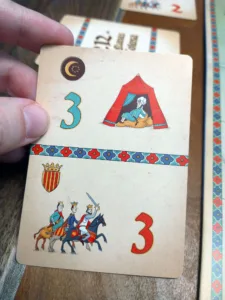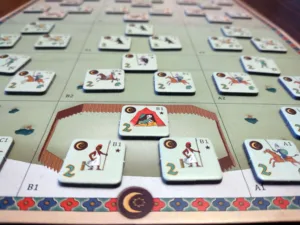 Admittedly, my knowledge of The Reconquista amounts to pretty much nothing; nevertheless, as a fan of card driven games, I was intrigued by this little package (and now I know a little more about the theme).
Admittedly, my knowledge of The Reconquista amounts to pretty much nothing; nevertheless, as a fan of card driven games, I was intrigued by this little package (and now I know a little more about the theme).
1212: Navas de Tolosa is a two player asymmetric tactical war game, playable in about forty-five minutes, that will pit the kingdoms of Castile, Aragon, and Navarre against the forces of the Almohad Empire.
Gameplay Overview:
Each of the chits in this game are marked to coincide with a space on the board. The Muslim player will set up on one side of the board and the Christian player on the other side, placing three chits into each of the corresponding spaces.

The game uses just 9 cards (plus reference cards and optional special powers). At the start of the game, each player is dealt three cards. The cards will each have two numbers between 1-6, one number in red for the Christian side, and one in green for the Muslim side. The three remaining cards will remain face-down and are used to determine attack strength later in the game. To begin, each player will play one of their cards face-down to determine initiative. Once the cards have flipped, the side that played the card with the highest number in their color will take the initiative and begin the round. They will then choose one of their two remaining cards to play face-up to the table; this will determine available action points (APs) for the turn.
The two sides are asymmetric, and each player has reference cards explaining how many points each action will cost (which is not always the same for both sides). Once you have spent your AP moving, refreshing units, and/or attacking, your turn ends and play goes to your opponent who plays a card that will determine their APs for the turn. When a player attacks, they indicate attack type, which units are attacking, and which space (usually adjacent) they are attacking into. The attacking player then flips the top card of the face-down deck and the red number will determine the attack strength for the Christian side, and the green for the Muslim side. These numbers will be modified by any special abilities and the damage dealt is the difference between the two numbers.
The round continues until both players have played all their cards. At the end of the round, the cards played to determine initiative at the start will return to their players’ hands. The rest of the cards are shuffled and two more dealt to each player (bringing their total back up to three). Play continues until the win condition for either side is met: either the Christian side eliminates the Muslim leader and achieve victory, or if the Christians have no units in the Muslim zone and occupy four or fewer zones overall (Muslim victory); either side can win by occupying twice as many zones as their opponent.

Gameplay Experience:
This game presents players with some interesting tactical decisions, beginning with which card to use for initiative—do you play a high card to up your chances of going first, or do you save it for the action points (APs)? The order in which you play your remaining cards will also matter, as well as how you spend your APs. Each side has its strengths: for example the Christians have a powerful cavalry attack, while the Muslims have strong archers and a potentially devastating counter-attack. Learning the finesse of these actions and when and how to implement them, is the key to success.

The asymmetry of the sides means it will take a couple plays to get a good feel for the strategy—you cannot take the same approach with each side. The Muslim side is much more mobile and flexible. The Christians, while straightforward and limited, have the potential to deal some powerful blows. And, as each side, you have three different forms of attack: cavalry, infantry, and archers, but how these work for each player will differ slightly.
The damage system is smooth and easy to understand: each unit has a life of two hits and when a unit takes damage, you just flip it to its reverse side. You can use an action to heal a unit, but doing so exhausts it, thus it won’t be able to be used to attack on the same turn it is healed (units that have been eliminated from the board cannot be healed).
The game presents an interesting back-and-forth experience, with both strategy and luck (with the cards) playing a big part, but it is also possible to memorize what has already been played, thus giving you a good idea of what is coming up and if it would be wise to attack or not. Sometimes you will just get bad cards and be limited as to what you can do, or feel that there is no viable action to take, which might mean wasting action points.

I must also mention the superb rule book, which is well refined and formatted with examples and clear explanations. I encountered only one instance of having to look up a rule online, where I easily found the answer. It was clear the designer got feedback and paid careful attention to questions that arose during play testing so that each one could be addressed. When it comes to war games, rule books are not always the strong suit; in this game, it is.
My biggest qualm with the game is that I do feel it becomes a little repetitive. While it’s playable in the listed time of 30 minutes, I did find it often took longer (45 min to an hour) as players will sometimes need to mull over their decisions. There is an advanced variant where each side gets two special one time use powers, which are kept secret, and that can add an element of surprise to the game, which is nice.
Final Thoughts:
This is a good game, make no mistake, but I did not find it intriguing enough to keep me coming back after several plays. The multi-use cards are clever and I respect what the game does with limited components. As an accessible two-player war game experience, I think this is a solid entry and well worth a try. But, at the end of the day, I think the same disparity of components and tight rules that make it so accessible are also what leave it feeling somewhat dry and abstract.
Final score: 3.5 Stars – An impressive feat in game design, worth checking out, but may have limited replay value.
 Hits:
Hits:
• Excellent rule book
• Meaningful tactical decisions
• Clever use of few components
Misses:
• Can feel repetitive
• Can run a little long





















